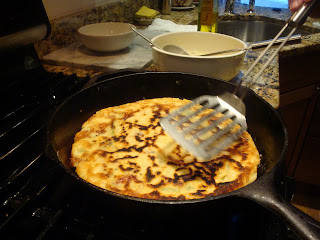
Really, I don't just copy The Kitchn. I promise!
A couple months ago, my friends Ed & Kari invited CCO and I over for brunch at their place and Kari made delicious Korean seafood pancakes. Being a cooking nerd, I took notes and photos! I had forgotten about it until recently, when I saw The Kitchn blogging on the same thing. I promise mine is better though.
 Say hello to Kari. She uses this Asian pancake mix as the base. You can find it at H-Mart. But really it's just flour with some salt mixed in. So you can just substitute flour and a pinch of salt if there's no Asian grocery nearby.
Say hello to Kari. She uses this Asian pancake mix as the base. You can find it at H-Mart. But really it's just flour with some salt mixed in. So you can just substitute flour and a pinch of salt if there's no Asian grocery nearby.Anyway, combine your pancake mix with 1 egg and the water. You should use an equal amount of pancake mix and liquid to make the batter. Assume the egg, if using, equals about 1/4 cup liquid. So if you're making two pancakes, use 3 cups mix and 2 3/4 cups water.
Once your batter is made, add in the seafood and stir until well mixed. You can use as much or as little as you want. Kari likes hers with a lot of seafood, so she puts in about 2 cups of frozen seafood mix that includes shrimp and squid. You could also use fresh.

The best pan to use for the pancake is a cast iron skillet. That gives it the nice browned crust on the pancake. After you've mixed the batter, preheat your skillet and grease with about 1 tbsp of oil.
 Once the skillet is heated, use a spoon to ladle about half the pancake mix into the skillet.
Once the skillet is heated, use a spoon to ladle about half the pancake mix into the skillet. The batter may be a little thick, so use your spoon to spread the batter out to the edge.
The batter may be a little thick, so use your spoon to spread the batter out to the edge.
Kari likes to add the scallions on top of the pancake. Once it's cooked for about a minute, lay the scallions on top of the pancake and spoon a little of the batter on top.

We break from our regular scheduled programming so Kari can give a hug to her son, who wandered into the kitchen looking for food.

After the pancake has cooked for about 3-5 minutes, it should have browned and firmed up around the edges. You'll be able to see on the top that it's solid. Use a pancake flipper to lift separate the edges of the pancake from the pan, then flip over. Cook the pancake for another five minutes or so until it's cooked all the way through. You can cut into the middle a little with a knife or the edge of the pancake flipper to check.

Flip your cooked pancake out onto a plate and cut into wedges. Serve with the dipping sauce of soy sauce and rice vinegar.
